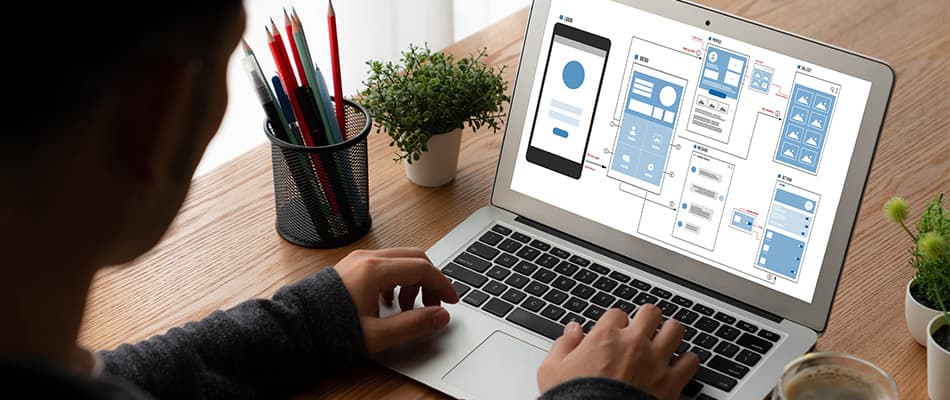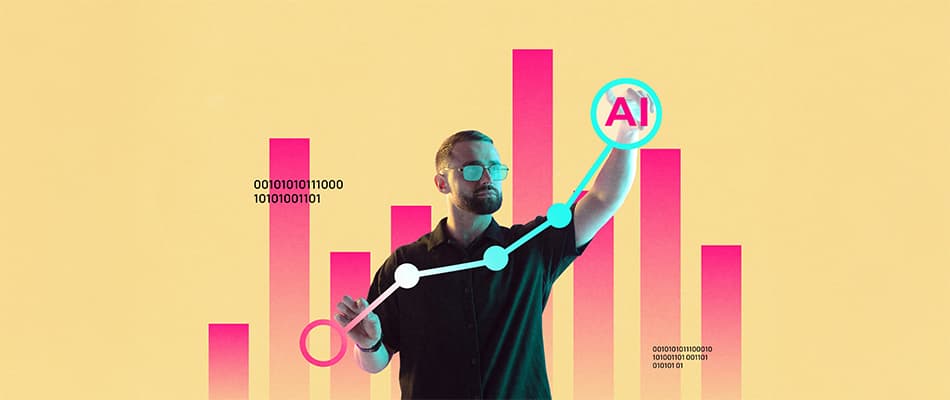Learn What is Web Interface Design. Explore Features and Elements
A well-designed web interface plays an important role in the success of websites and online applications. It serves as the visual layer that connects users to the technology behind a platform. The web interface makes it easy to browse, click, and access information from a website. Understanding what is web interface is essential for designing engaging and functional digital experiences.
Web interface design focuses on creating layouts, visuals, and interactive elements that improve user experiences. It ensures that users can perform tasks smoothly, whether filling out forms, going through pages, or using online tools. A well-crafted web interface can make a website or application not only easy to use but also visually appealing.
In this article, we will explore the meaning of a web interface, its types, elements, and features. You will also learn how to design a web interface in simple steps.
What is a Web Interface?
A web interface is the part of a website or application that users see and interact with. It acts as a medium between users and the system. It allows users to perform tasks like browsing, clicking buttons, or filling out forms. The design of the web interface ensures users can easily find and use the features they need. As we learn what is web interface, we should know that there are different types of web interfaces designed for specific needs. For example:
1. Database Web Interface
This interface allows users to manage and access online data easily. It connects users to the data, simplifying tasks such as adding, retrieving, or updating information. These interfaces are common in systems like Customer Relationship Management (CRM) and e-commerce platforms.
2. Responsive Web Interface
This interface adjusts to different screen sizes, ensuring usability on desktops, tablets, and smartphones. It provides an easy experience by modifying layouts and elements to fit the device. This makes it easier for users to interact with the website.
Discover What is Responsive Design Here!

Types of Web Interface
Web interfaces come in different forms to meet various user needs. They define how users interact with websites and applications. Understanding what is web interface helps in choosing the right type for a specific task. Each type offers unique features that cater to different audiences and purposes. Some interfaces focus on visual interaction, while others depend on voice or text commands.
The following are the web interface types:
- Graphical User Interface (GUI): A GUI uses visual elements like icons, buttons, and menus to help users interact with a system. It is widely used in websites and applications because it is user-friendly and requires minimal technical knowledge.
- Touch User Interface: This interface works through touch-based input on devices like smartphones and tablets. It is ideal for mobile users and allows for easy navigation with gestures like swiping and tapping.
- Menu-Driven Interface: In a menu-driven interface, users choose options from a list of menus. It is simple to use and works well for applications with limited features, such as ATMs, Kiosks, or basic websites.
- Command-Line Interface: A CLI requires users to type text commands to interact with the system. It is less user-friendly but offers advanced functionality for developers and IT professionals.
- Natural Language Interface (NLI): An NLI allows users to communicate with a system using plain language. This type is often used in chatbots and AI assistants, making interactions more conversational.
- Voice User Interface (VUI): A VUI relies on voice commands for interaction. It is commonly found in virtual assistants like Alexa or Siri. It allows hands-free operation for users.
What is Web Interface Design?
Web interface design focuses on developing the visual and interactive aspects of websites and applications. It involves organising elements like layouts, buttons, input fields, and forms to make digital platforms simple and easy to use. This process ensures that users can perform tasks like browsing content or accessing information without issues. By focusing on usability, web interface design helps create a smooth and engaging experience for the audience. Being aware of what a web interface is is essential for building user-friendly websites and applications.
A thoughtfully crafted web interface goes beyond just functionality. It makes websites and applications visually appealing while fulfilling user needs. Designers carefully arrange features to guide users naturally through the platform, enabling them to interact with various elements efficiently. Whether it’s a shopping site, an educational platform, or a business tool, web interface design is crucial in making the user experience intuitive and satisfying.
Explore What Is User Experience and User Interface Here
Elements of Web Interface Design
Web interface design is built using various elements that enhance usability and user interaction. These elements ensure users can interact easily with websites and applications. Each element serves a unique purpose, making it crucial to understand what is web interface and how these components work together. A structured interface includes these parts to create smooth user experiences.
Listed below are the elements of web interface design:
1. Buttons
They are clickable elements that allow users to perform actions, such as submitting information or going to another page. They must be visually clear and intuitive to ensure users know where to click and what to expect.
2. Icons
These are small visual elements that represent actions, features, or information. They provide visual cues to guide users, making interactions simpler and more intuitive. Using meaningful icons ensures a better understanding of what is web interface functionality.
3. Navigation Components
These elements, like menus and links, help users move across a website or app. Clear and logical accessibility improves usability and ensures users find what they need quickly and effortlessly.
4. Input Fields
They enable users to provide information, such as entering text or selecting options. Examples include search bars and login forms. These fields must be easy to use and visually different, ensuring clarity for users.
5. Information Components
These include tooltips, notifications, and pop-ups that convey information to users. They help users understand system processes, confirm actions, or highlight errors, improving interaction clarity and effectiveness.
6. Containers
They group related elements, such as sections or cards, to organise content in a systematic manner. Properly structured containers enhance readability and help users access the interface.
Feature of Web Interface
A web interface plays an important role in how users interact with a website. It includes various elements that make the overall experience simple and enjoyable. A well-designed interface combines aesthetics and functionality to ensure that users can get what they are looking for. It should cater to a wide audience, including those with diverse devices and accessibility needs.
Now that you know what a web interface is, let’s learn about its features:
- Simplicity in Layout: A simple and clean layout ensures that users can easily find what they are looking for without confusion. Clear spacing, neat alignment, and uncluttered designs improve the overall experience.
- Responsive Design: Web interfaces must adapt to different screen sizes and devices. A responsive design makes it easy to use a website on mobiles, tablets, and desktops without compromising functionality or appearance.
- User-Friendly Navigation: Easy-to-follow menus, buttons, and links make browsing simple. When users can intuitively move through a website, it improves satisfaction and engagement.
- Consistency in Design: Uniform design elements such as fonts, colours, and button styles across pages create a cohesive and professional appearance. This helps users feel familiar with the interface as they browse.
- Accessible Content: An accessible web interface ensures all users, including those with disabilities, can interact with the website. Features like text alternatives for images and keyboard-friendly controls make it inclusive.
- Engaging Visuals: Images, icons, and videos add a visual appeal to the interface. These elements keep the design interesting without overwhelming users.
- Fast Loading Speed: A good web interface prioritises performance by loading quickly, even with multimedia elements. Slow websites can frustrate users and lead to a higher bounce rate.
- Clear Call-to-Actions: Buttons or prompts that guide users on the next steps, such as “Sign Up” or “Learn More,” should stand out. Their design and placement should make them easy to notice and click.
Learn How to Design a Website Here!
How to Design a Web Interface?
Designing a web interface is a structured process that combines creativity and strategy. It begins with learning what is web interface and its role in connecting users with digital platforms. This process ensures that the interface is both functional and appealing. It involves defining the objectives, designing the layout, and continuously refining the elements to meet user expectations. Proper planning, visual design, and feedback collection are essential for creating a user-friendly interface. Each step contributes to delivering an engaging experience.
The step-by-step process of designing a web interface is given below:
1. Understand the Audience
Start by identifying the users and their preferences. This step helps in creating a web interface that meets the needs and expectations of the target audience. User research and feedback collection play a significant role in this phase.
2. Define Objectives and Information Architecture
Establish clear goals for the interface. Having a deep knowledge of what is web interface helps organise the content and features logically, simplifying browsing and enhancing usability. Proper organisation ensures users can find information easily.
3. Create Wireframes
Wireframes provide a blueprint for the interface layout. They outline the placement of elements like buttons, input fields, and icons. This step is crucial for visualising a web interface and aligning it with user expectations.
4. Develop Visual Design
Focus on colour schemes, typography, and graphics to create an attractive interface. Ensure that the design is consistent and visually appealing, reflecting the purpose and branding of the website or application.
5. Build Prototypes
Prototypes offer a functional preview of the interface. They help test the usability of design elements and identify areas that need improvement before final implementation.
6. Test and Improve
Conduct usability testing to gather feedback from users. Knowing what is web interface helps ensure the interface is functional and user-friendly. Continuous improvement is key to addressing issues and delivering an easy and helpful experience.
Why Enrol in the Digital Regenesys Full Stack Web and Software Development Course?
The Digital Regenesys’s Full Stack Web & Software Development course is a 36-week online course. It equips learners with the necessary skills to build both front-end and back-end web applications. Throughout this course, students will explore topics like HTML, CSS, and Express.js, with a focus on creating interactive and secure websites. The curriculum integrates both theoretical learning and practical experience, giving students the ability to create user-friendly websites. This course helps you learn what is web interface and how to create one.
Below are the benefits of enrolling in this course:
- Recognition: Earn a globally recognised certification, which enhances credibility.
- In-depth Curriculum: Explore a detailed curriculum covering essential front-end and back-end technologies.
- Experienced Faculty: Learn from highly skilled professionals who bring practical industry experience and insights into the classroom.
- Online Learning: Benefit from an online learning mode with weekend classes, providing flexibility.
- Practical Learning: Work on practical projects to gain valuable experience in web development.
In conclusion, understanding what is web interface is crucial for anyone looking to design websites or applications. A carefully designed web interface ensures users can interact with digital platforms effortlessly, making their experience more useful and easy. By learning the fundamentals of web interface design, including layout, visual elements, and interactivity, you can create functional and attractive platforms. Enrolling in a course like the Digital Regenesys Full Stack Web & Software Development course can help you gain the skills necessary to design user-friendly and visually appealing web interfaces.
What is Web Interface? – FAQs
What is the web interface meaning?
A web interface refers to the visual and interactive elements of a website or application that users interact with to perform tasks easily.
What are the features of a web interface?
A web interface typically includes user-friendly design, responsiveness across devices, intuitive navigation, fast loading times, and accessibility features for an improved user experience.
What are web interface design tools?
Web interface design tools like Figma, Adobe XD, and Sketch help create intuitive, functional, and visually attractive web interfaces through wireframing and prototyping.
Can you give some web interface examples?
Examples of web interfaces include the layouts of e-commerce websites, mobile apps, and online banking platforms, focusing on user-friendly navigation and visual appeal.
What are the types of web interfaces?
Web interfaces include Graphical User Interface (GUI), Command-Line Interface (CLI), Voice User Interface (VUI), and Menu-Driven Interface, each designed for different user needs.














